 Aquatic Insects of Michigan
Aquatic Insects of Michigan
by Ethan Bright, Museum of Zoology Insect Division and School of Natural Resources and Environment
University of Michigan
- Home
- Species Lists
- Coleoptera
- Diptera
- Ephemeroptera
- Acanthametropodidae
- Ameletidae
- Ametropodidae
- Arthropleidae
- Baetidae
- Baetiscidae
- Behningiidae
- Caenidae
- Ephemerellidae
- Ephemeridae
- Heptageniidae
- Isonychiidae
- Leptohyphidae
- Leptophlebiidae
- Metretopodidae
- Neoephemeridae
- Oligoneuriidae
- Palingeniidae
- Polymitarcyidae
- Potamanthidae
- Pseudironidae
- Siphlonuridae
- Heteroptera
- Hymenoptera
- Lepidoptera
- Megaloptera
- Neuroptera (Sisyridae)
- Odonata
- Orthoptera
- Plecoptera
- Trichoptera
- Other Orders
- Keys/Identification
- Aquatic Insects of Michigan
Anax Leach (Aeshnidae) - Green Darners
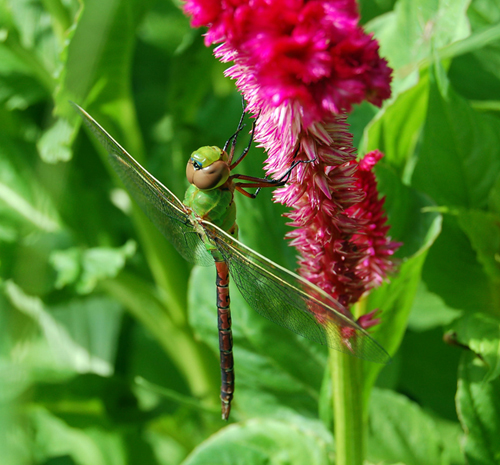 The genus Anax is widespread in temperate and tropical regions of the world. Four species are found in the New World, two of which are found in Michigan. These are large nymphs found in still waters (ponds, lakes and still portions of streams) clinging to aquatic vegetation, and frequently where fish predation is not a significant factor. Adults are large, green and reddish dragonflies.
The genus Anax is widespread in temperate and tropical regions of the world. Four species are found in the New World, two of which are found in Michigan. These are large nymphs found in still waters (ponds, lakes and still portions of streams) clinging to aquatic vegetation, and frequently where fish predation is not a significant factor. Adults are large, green and reddish dragonflies.
A. junius is a common resident of small and large lentic habitats throughout Michigan, and less frequently in very slow-moving streams and rivers with ample aquatic vegetation. Apparently two populations with different emergence periods exist in the northern part of its range (Trottier 1966, 1971). One (non-resident) population apparently migrates northward to oviposit in spring (these typically are the first odonates to appear in the year), with nymphs rapidly developing until a September emergence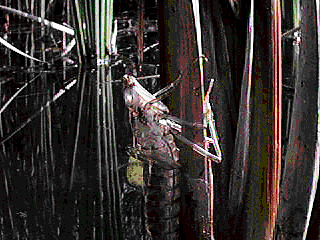 , when emerged adults migrate southwards. Another cohort apparently stays year-round, with ovipositing occurring in July, with some egg diapause and subsequent larval development during winter and spring until a June emergence. Work should be done to determine whether these populations can be genetically distinguished. A. longipes was added to Michigan's list (Kielb and O'Brien 1997), with a thriving population found in several experimental, fishless ponds at the E. S. George Reserve in Livingston County, southeastern (LP) Michigan. Since then, numerous sightings of adult A. longipes have been made in the area. This species is probably our largest dragonfly, with mature nymphs exceeding 60 mm in total length. Emergence of the population at ESGR occurs from mid-June through early August.
, when emerged adults migrate southwards. Another cohort apparently stays year-round, with ovipositing occurring in July, with some egg diapause and subsequent larval development during winter and spring until a June emergence. Work should be done to determine whether these populations can be genetically distinguished. A. longipes was added to Michigan's list (Kielb and O'Brien 1997), with a thriving population found in several experimental, fishless ponds at the E. S. George Reserve in Livingston County, southeastern (LP) Michigan. Since then, numerous sightings of adult A. longipes have been made in the area. This species is probably our largest dragonfly, with mature nymphs exceeding 60 mm in total length. Emergence of the population at ESGR occurs from mid-June through early August.
Adults (Adapted from Needham et al. 2000)
| 1a | a. Postfrons entirely green, without dark markings) | Anax longipes Hagen |
| b. Occiput black | ||
| c. Abdomen often red | ||
| 1b | a. Postfrons with a rounded central black or brown spot, surrounded anteriorly and laterally with a blue semicircle (see b) | Anax junius (Drury) |
b. Occiput yellowish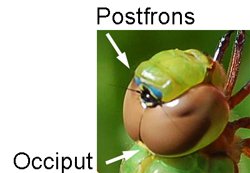 |
||
c. Abdomen greenish; brownish or red in females as below  |
Mature Nymphs (Adapted from Needham et al. 2000)
| 1a | a. Total length of mature nymph >60 mm | Anax longipes Hagen |
b. Folded labium passes metacoxa towards first abdominal segment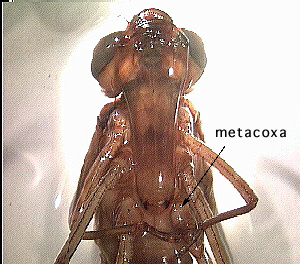 |
||
c. Labial lobes clearly truncated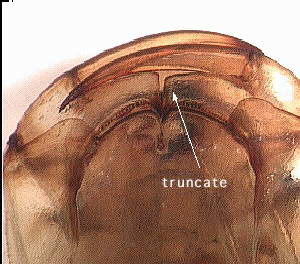 |
||
| 1b | a. Total length of mature nymph <55 mm | Anax junius (Drury) |
b. Folded labium clearly does not reach beyond metacoxa 3)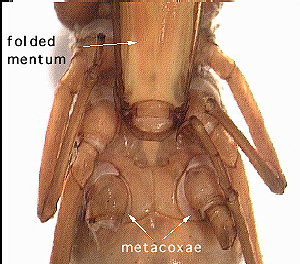 |
||
c. Distal edge of labial lobes somewhat rounded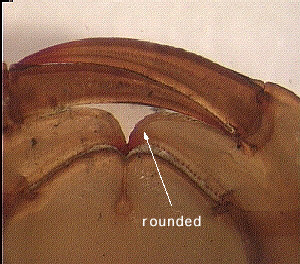 |
References
Kielb MA, O'Brien MF. 1997. Discovery of an isolated population of Anax longipes in Michigan (Odonata: Aeshnidae). Great Lakes Entomologist 29(3):161-164.
Needham JG, Heywood HB. 1929. A Handbook of the Dragonflies of North America (Anisoptera). C. C. Thomas: Springfield, Illinois, USA. 378 p.
Needham JG, Westfall MJ, May ML. 2000. Dragonflies of North America, Revised Edition. Scientific Publishers, Gainesville, Florida, USA. xv + 939 p.
Trottier R. 1966. The emergence and sex ratio of Anax junius Drury (Odonata: Aeshnidae) in Canada. The Canadian Entomologist 98:794-798.
Trottier R. 1971. Effect of temperature on the life-cycle of Anax junius (Odonata: Aeshnidae) in Canada. The Canadian Entomologist 103:1671-1683.
Page created: October 23, 1998 - Last updated: February 28, 2017 (EB)